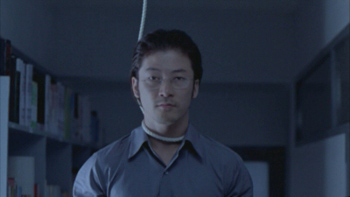
Last Life in the Universe is a little piece of perfection. Kenji is a Japanese man who lives in Thailand but doesn't speak the language. His apartment is so clean that he doesn't have much to do besides sit in it. The few items in his refrigerator are aligned just so, and the clothes in his closet are all the same. His many books are stacked neatly in columns on the floor with a little label on the wall above each pillar, like a high-water mark. Kenji works at a Japanese cultural center in Bangkok where his duties are similar to a librarian's, but he spends most of his time contemplating suicide.
He imagines one scenario that goes like this: he steps onto a stack of books in his apartment, slips his neck into a loop of rope, then kicks the books away and hangs above the pile, dripping blood over the pages. As played by Tadanobu Asano, Kenji speaks less than the hired bodyguard in Zatoichi, coincidentally played by the same actor, so he's not the kind to say much about why he wants to kill himself. Loneliness, it seems. Maybe his exceedingly ordered life is a prison, and kicking over a stack of books would be the perfect escape.
Through a dramatic turn of events, Kenji meets a young Thai woman named Noi and becomes a guest at her house, a spacious seaside home that's so messy it takes something like personal rebellion for Kenji to set foot inside. The film is shot by Christopher Doyle, one of the few cinematographers who's nearly as well known — or in this case probably better known — than the directors he works for. He shot Zhang Yimou's Hero and many of Wong Kar-Wai's movies, and he has a well-deserved reputation as a photographer who could light a heap of trash and make you want to hug it to your breast. He gets the opportunity to do just that in Last Life in the Universe, where even a house that's one moldy can of beans away from condemnation looks ravishing.
As Kenji spends time at Noi's house, the story lingers on the tenuous connection between these two people and their opposing temperaments. Neither speaks the other's language, so they communicate in broken English most of the time. Kenji discovers a teach-yourself-Japanese cassette tape in Noi's rubble, and although it's meant for Thai speakers, he listens to it anyway.
In these moments Last Life in the Universe is as inviting as a warm blanket, with its perfectly symmetrical elements, its perfectly lit filth, and its perfectly alienated people. What's most disappointing is that, as ambitious as they appear, the filmmakers seem to be satisfied with these few simple patterns. The clichés of modern life — the malaise of people who are lonely in a crowd and the irony that's so expected it's no longer ironic — have never looked more attractive. The movie is a mirror, completing all of its own half-circles rather than reflecting life back at the audience. It's a fully contained ecosystem with little need for the real world, content with the urban hum of an artificial feedback loop. The "universe" of the title is a fishbowl with plastic plants.
Writer-director Pen-Ek Ratanaruang is a fan of Jim Jarmusch, and he shares some of his preoccupations, such as wryly downplaying the language differences of his characters and showing more interest in household minutia than any drama going on outside. The movie also reminds me of Tsai Ming-Liang's What Time is it There, with its parallels, connections, and criss-crossing cultures. It's when Ratanaruang moves his characters beyond the moment that the plot feels forced. Some critics have compared the film to Sofia Coppola's Lost in Translation, in which a mismatched pair of travellers find each other in a cloud of melancholy, but Lost in Translation uncovers little bits of truth about people, and Coppola lets her characters — and her story — drift delicately through indistinct thoughts and honest emotions. By contrast, Ratanaruang orchestrates his characters to attract or repel each other like magnets spinning on axes, adjusting the angles to arrive at an optimally clever conclusion. The movie feels something like Kenji's apartment, overly neat, and I kept hoping that someone would knock things over, but every time someone did, the pieces fell right into place.
Despite all that, the movie is entrancing. The camera glides through Noi's house, and at one point household objects hang in mid-air, recalling the swirling vortex of leaves in Hero. This sort of moody visual poetry is the highlight of a movie whose pleasures come not from peace and understanding, and not even from observing human foibles, but from watching a lizard on an apartment wall or looking down from the upper corner of a room at a claw-footed bathtub, slanting across the screen like it might slide over the floor if someone gave it a nudge. The performances are spot-on, the ample humor is gentle and dark, and the guns and gangsters are thankfully minor. Ratanaruang's playful flourishes are exciting — he swaps actresses late in the game, experiments with dream-vs-reality, and shows his opening title some 30 minutes into the movie — but more than anything they make me curious to see what he'll do next.
